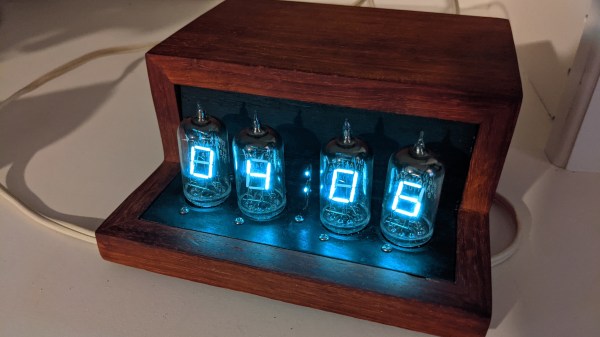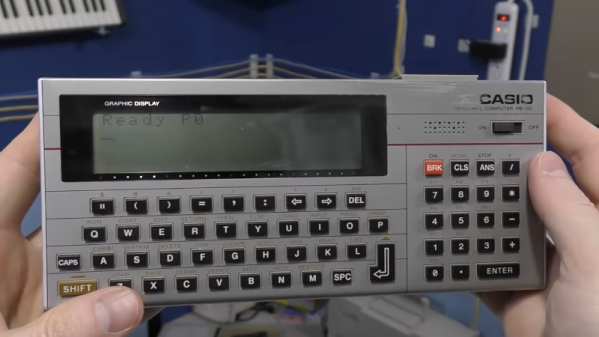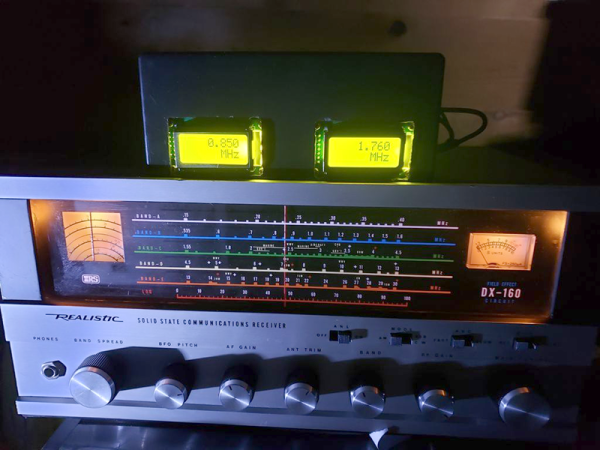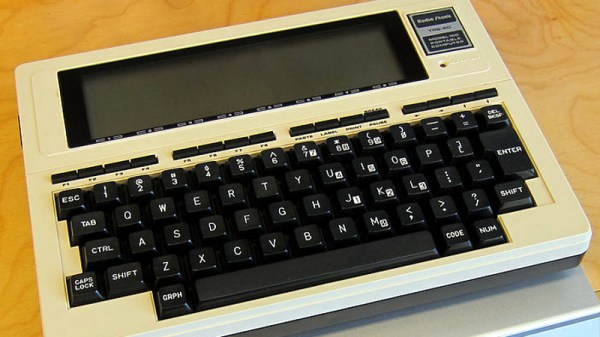We always like to call out a commercial success stemming from projects that got their start on Hackaday.io, and so we’re proud to announce the release of MAKE: Calculus by Joan Horvath and Rich Cameron, a book that takes a decidedly different approach to teaching calculus than traditional courses. Geared to makers and hackers, who generally tend to have a visual style of learning, the book makes heavy use of 3D-printed models to illustrate the relationships between functions. The project started five years ago as a 2017 Hackaday Prize entry, and resulted in a talk at the 2019 Supercon. Their book is now available for preorder, and might be a great way to reacquaint themselves with calc, or perhaps even to learn it for the first time. Continue reading “Hackaday Links: July 10, 2022”
radio shack39 Articles
Captivating Clock Puts Endangered Displays On Display
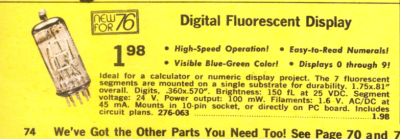
When you have a small stock of vacuum fluorescent displays (VFDs) straight out of the 1976 Radio Shack catalog, you might sit around wondering what to do with them. When [stepawayfromthegirls] found out that his stash of seven DT-1704A tubes may be the last in existence, there was no question. They must be displayed! [stepawayfromthegirls]’ mode of display is this captivating clock build. Four VFDs with their aqua colored elements are set against a black background in a bespoke wooden case. Looking under the hood, the beauty only increases.
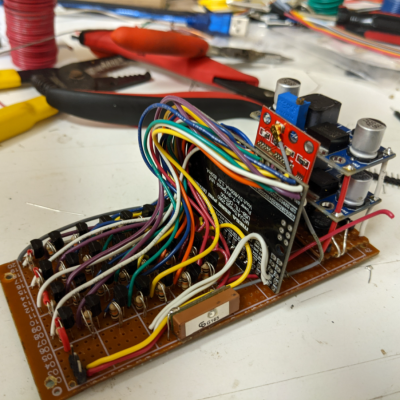
Keeping the build organized was not an easy task because the tubes are designed in such a way that each segment must be individually controlled. The needed I/O duties are provided by an Arduino Mega 2560 Pro (Embed). 28 2n3904’s each with their two resistors serve as drivers for each VFD segment.
The output of a 24 V AC transformer left over from the 1980s is rectified to 34 V of DC power which is then regulated to 27 V to power the tubes. Switching power supplies provide 6 V to the Arduino and 1.3 V to the filaments. If you look closely, you’ll also see a GPS module so that the clock doesn’t need to be set. To future-proof the clock against daylight savings time adjustments, a potentiometer on the back of the case allows the user to set custom hour offsets without editing any code.
We think the end result is a remarkably clean, simple, and elegant clock that he will be proud of for many years to come!
If VFD clock builds are your thing, then you’ll enjoy this Network Attached VFD Clock and a Mini VFD Clock with floating display. And while not VFD based, we’d be silly to leave out the Boat Anchor Nixie Clock with enough knobs, switches, and buttons to delight even the fussiest of hacker.
A Computer In Your Pocket, 1980s Style
These days, having a little computer in your pocket is par for the course. But forty years ago, this was a new and high tech idea. [The 8-Bit Guy] has a great video covering the state of the art in pocket computers and personal digital assistants from the 1980s and 1990s. You can see the video below.
There are a lot of familiar faces on the video including the Radio Shack pocket computers, Palm Pilots, and some more obscure machines of varying quality.
It might impress you to know that the Radio Shack TRS-80 PC-1 pocket computer actually had two CPUs. Of course, each CPU was a 4-bit processor running at 256 kHz, so maybe not as impressive as it sounds. Still, what a marvel in its day, programming BASIC on a 24-character LCD.
RadioShack To Be Reborn As Online-First Retailer
The good news is that as of today RadioShack has officially been purchased by Retail Ecommerce Ventures (REV), giving the troubled company a new lease on life. The downside, at least for folks like us, is that there are no immediate plans to return the iconic electronics retailer to its brick-and-mortar roots. As the name implies, REV specializes in online retail, having previously revamped the Internet presence of other bankrupt businesses such as Pier 1 Imports and Dressbarn.
 While the press release doesn’t outright preclude the possibility of new physical RadioShack locations, it’s clear that REV believes the future of retail isn’t to be found in your local strip mall. As the US mulls further lockdowns in response to the continuing COVID-19 pandemic, it’s hard to disagree. There will be millions of bored kids and adults looking for something to do during the long winter nights, and an electronic kit or two shipped to their door might be just the thing.
While the press release doesn’t outright preclude the possibility of new physical RadioShack locations, it’s clear that REV believes the future of retail isn’t to be found in your local strip mall. As the US mulls further lockdowns in response to the continuing COVID-19 pandemic, it’s hard to disagree. There will be millions of bored kids and adults looking for something to do during the long winter nights, and an electronic kit or two shipped to their door might be just the thing.
REV says they plan to relaunch the rather dated RadioShack website just in time for the company’s 100th anniversary in 2021. As of this writing the website currently says that sales have been temporarily halted to allow for inventory restructuring, though it’s unclear if this is directly related to the buyout or not. Getting an accurate count of how much merchandise the company still has on hand after shuttering the majority of their physical locations in 2017 certainly sounds like something the new owners would want to do.
Like most of you, we have fond memories of the Golden Age of RadioShack, back before they thought selling phones and TVs was somehow a good idea. To their credit, they did try and rekindle their relationship with hackers and makers by asking the community what they’d want to see in their stores. But we all know how that story ended. While it doesn’t look like this news will get us any closer to having a neighborhood store that stocks resistors, there’s a certain comfort in knowing that RadioShack kits and books will still be around for the next generation.
An Old Calculator Lives Again
There was a time when any electronics student would have a slide rule hanging off their belt. By the 1970s, the slide rule changed over to an electronic calculator which was a pricy item. Today you can buy calculators at the dollar store. [JohnAudioTech] pulled out an old Radio Shack vacuum fluorescent display (VFD) calculator and found it didn’t work. Obviously, that means it is time to open it up.
It is fun to see one of these old devices opened up again. Consumer electronics with big through-hole ICs! Troubleshooting the device wound up being anti-climatic, as a broken wire to the battery compartment explained the whole thing.
As a teardown, though, this is a fun video. Not only are all the parts through-hole, but the PCB is clearly a manual layout with serpentine traces flowing across the board like some sort of art piece. Continue reading “An Old Calculator Lives Again”
Radio Shack Shortwave Goes Digital
If you spent the 1970s obsessively browsing through the Radio Shack catalog, you probably remember the DX-160 shortwave receiver. You might have even had one. The radio looked suspiciously like the less expensive Eico of the same era, but it had that amazing-looking bandspread dial, instead of the Eico’s uncalibrated single turn knob number 1 to 10. Finding an exact frequency was an artful process of using both knobs, but [Frank] decided to refit his with a digital frequency display.
Even if you don’t have a DX-160, the techniques [Frank] uses are pretty applicable to old receivers like this. In this case, the radio is a single conversion superhet with a variable frequency oscillator (VFO), so you need only read that frequency and then add or subtract the IF before display. If you can find a place to tap the VFO without perturbing it too much, you should be able to pull the same stunt.
Where Did Pocket Computing Start?
A smartphone in 2019 is an essential piece of everyday equipment. Many of you are probably reading this page on one, and it will pack a very significant quantity of computing power into your hand. Pocket computing has a long history stretching back decades before the mass adoption of smartphones though, and Paleotronic has an interesting retrospective of that earlier history.
The piece starts with the Radio Shack PC-1, a rebadged Sharp with a calculator-style keyboard and a one-line alphanumeric LCD display, then continues through the legendary TRS-80 Model 100 to the era of the palmtop. It’s a difficult subject to cover in its entirety as there are so many milestones on the pocket computing path, but it’s an interesting read nevertheless as it successfully evokes the era when a 300 Baud connection via an acoustic coupler was a big deal. We might for example have mentioned the Atari Portfolio if only for its use by a young John Connor to scam an ATM in Terminator 2, and as any grizzled old sysadmin will tell you, there was a time when owning a Nokia Communicator might just save your bacon.
Of the classic pocket computing devices mentioned, only one has received significant coverage here. The TRS-80 model 100 still has a huge following, and among quite a few hacks featuring it we’ve seen one brought into the smartphone age by getting the ability to make a cellular connection.
TRS-80 Model 100 image: Jeff Keyzer from Austin, TX, USA [CC BY-SA 2.0]


